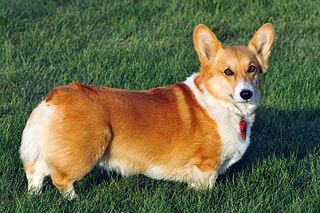
The Welsh Corgi is a small type of herding dog that originated in Wales. The name corgi is derived from the Welsh words cor and ci, meaning "dwarf" and "dog", respectively.

The Shih Tzu is a toy dog breed originating from Tibet and was bred from the Pekingese and the Lhasa Apso.
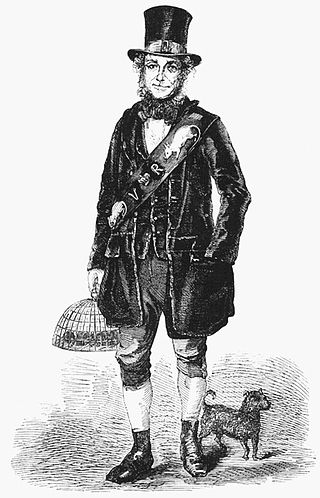
Jack Black was a rat-catcher and mole destroyer from Battersea, England during the middle of the nineteenth century. Black cut a striking figure in his self-made "uniform" of a green topcoat, scarlet waistcoat, and breeches, with a huge leather sash inset with cast-iron rats. Black promoted himself as the Queen's official rat-catcher, but he never held a royal warrant.

The Pekingese is a breed of toy dog, originating in China. The breed was favored by royalty of the Chinese Imperial court as a companion dog, and its name refers to the city of Peking (Beijing) where the Forbidden City is located. The breed has several characteristics and health issues related to its unique appearance. Because of its desirable characteristics, the Pekingese has been part of the development of designer crossbreeds, such as the Peekapoo and Peke-a-tese.

The Pembroke Welsh Corgi is a cattle herding dog breed that originated in Pembrokeshire, Wales. It is one of two breeds known as a Welsh Corgi. Pembroke Welsh Corgis descended from the Spitz family of dogs. The other is the Cardigan Welsh Corgi, which descend from the Teckel family of dogs, which also produced the Dachshund.
Toy dog traditionally refers to a very small dog or a grouping of small and very small breeds of dog. A toy dog may be of any of various dog types. Types of dogs referred to as toy dogs may include spaniels, pinschers and terriers that have been bred down in size. Not all toy dogs are lap dogs.

A lap dog or lapdog is a dog that is both small enough to be held in the arms or lie comfortably on a person's lap and temperamentally predisposed to doing so. Lapdog is not a specific breed, but a generic term for a type of dog that is small in size and friendly towards humans.

The Tibetan Spaniel is a breed of assertive, small dogs originating in Tibet. This breed is not a spaniel in the original meaning of the term; its breeding differs from other spaniels, and unlike true spaniels, which are gun dogs, the Tibetan spaniel is a companion dog. The spaniel name may have been given due to its resemblance to the bred-down lapdog versions of the hunting spaniels, such as the Cavalier King Charles spaniel.
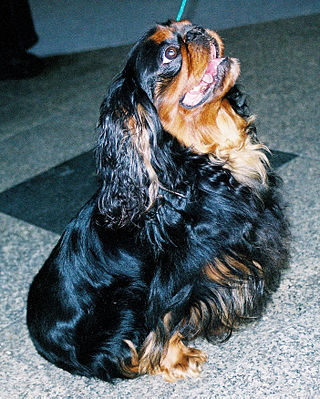
The King Charles Spaniel is a small dog breed of the spaniel type. In 1903, the Kennel Club combined four separate toy spaniel breeds under this single title. The other varieties merged into this breed were the Blenheim, Ruby and Prince Charles Spaniels, each of which contributed one of the four colours available in the breed.
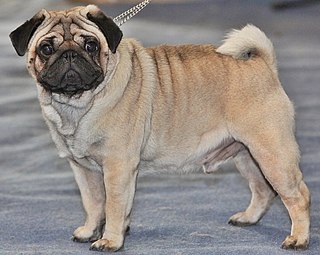
The Pug is a breed of dog originally from China, with physically distinctive features of a wrinkly, short-muzzled face, and curled tail. The breed has a fine, glossy coat that comes in a variety of colors, most often fawn or black, and a compact, square body with well developed and thick muscles all over the body.

Dash (1830–1840) was a King Charles Spaniel owned by Queen Victoria. Victoria's biographer Elizabeth Longford, called him "the Queen's closest childhood companion", and in the words of the Oxford Dictionary of National Biography, he "was the first in a long line of beloved little dogs".
Ch. Midkiff Seductive, a Cocker Spaniel, was the Best in Show at the 1921 Westminster Kennel Club Dog Show, the first occasion it was awarded to a member of that breed. The judging in the Best in Show round had a split decision by the two judges, and required the referee to make a deciding vote.
Susan was a Pembroke Corgi dog owned by Queen Elizabeth II that was given to her on her eighteenth birthday. Following the dog's death in 1959, the Queen personally designed a headstone for her grave at Sandringham House. Susan was the first of a long line of Corgis and Dorgis owned by the Queen, all of them descended from Susan. The dogs often accompanied the Queen in her public appearances, and thus came to feature prominently in her public image.

There were many animals aboard the RMS Titanic during her disastrous maiden voyage, which ended with the ship sinking on 15 April 1912 after colliding with an iceberg.
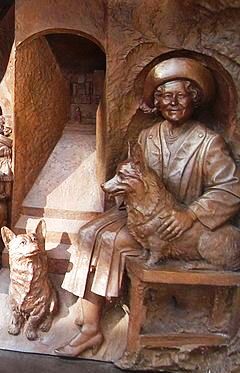
The royal corgis are the Pembroke Welsh Corgi dogs formerly owned by Queen Elizabeth II and her parents, King George VI and Queen Elizabeth The Queen Mother. Fond of corgis since she was a small child, Elizabeth II owned more than 30 corgis from her accession in 1952 until her death in 2022. She owned at least one corgi throughout the years 1933 to 2018.

Queen Victoria and her close family kept numerous pet animals, including:
Dookie or Rozavel Golden Eagle was a Pembroke Welsh Corgi bought in 1933 by King George VI and was the first of many Welsh Corgis to join the Royal Family. The dog was especially popular with Queen Elizabeth II, who from then on owned over thirty corgis in her lifetime.

John Hart Dunne K.C.B. (1835–1924) was a British soldier of Irish descent, who served in several major campaigns of the nineteenth century.

Frances Caroline Fairman was a British watercolourist, a painter in oils, and an illustrator. In her lifetime she was best known for her canine portraits, some of which were commissioned by royalty and aristocracy. She was known as "the Lady Landseer" for the quality of her work. She travelled to the Americas, France, and Switzerland, returning with watercolour landscape sketches.

The Indian Kiosk is located at Frogmore, in the Home Park of Windsor Castle, in Berkshire, England. The kiosk comes from India and was originally designed for the Qaisar Bagh, a palace complex in the city of Lucknow. The palace was looted by British soldiers following the suppression of the Indian Rebellion of 1857 and the kiosk was brought to England by Charles Canning, Governor-General of India, and presented to Queen Victoria. The Queen sited it in her private gardens at Frogmore, near the mausoleum to her mother. It is a Grade II listed structure.















